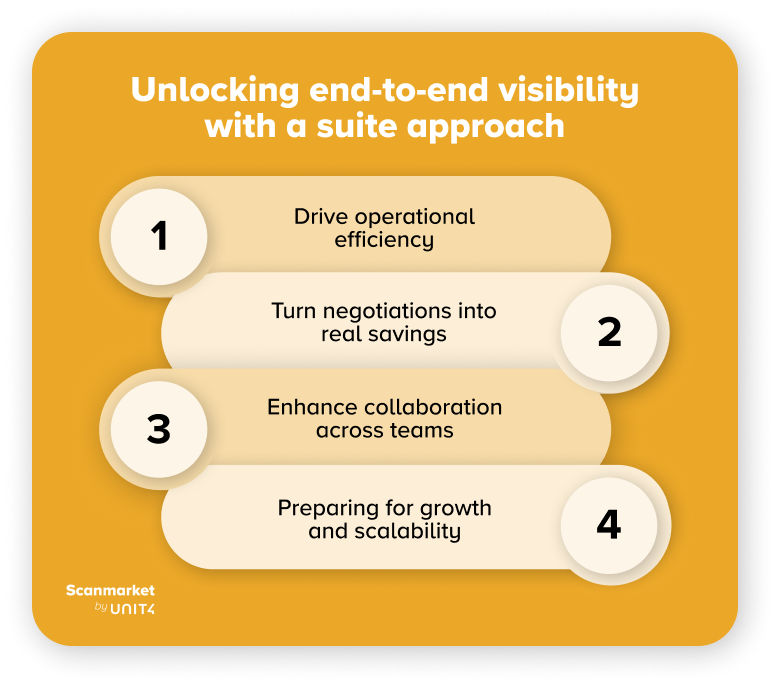The Suite Approach: 4 reasons why an integrated S2C solution is a game changer
Procurement leaders face an increasingly complex operating environment, with many dealing with fragmented legacy tools, manual processes, but only rising expectations from stakeholders and increasing compliance mandates.
For organizations navigating this landscape, the decision to invest in the digital transformation of procurement is pivotal. The question is, should you opt for a patchwork of individual tools or a truly integrated Cloud procurement suite?

In this blog, we provide procurement leaders with 4 compelling reasons to adopt an integrated S2C Cloud platform while addressing how it solves their most pressing challenges – learn more with Unit4.
Why fragmented systems will hold your team back
Many organizations rely on a complicated integration of standalone modules or tools for sourcing, contracting, and supplier management.
While these tools may address specific needs, they often create silos that hinder overall efficiency. Manually transferring data between systems increases the risk of errors and slows down decision-making. Fragmented systems complicate reporting, making it harder to identify trends or measure performance effectively.
Without a unified system, it’s challenging to maintain consistent processes, monitor compliance, or ensure that negotiated savings are realized. These inefficiencies not only drain resources but also put organizations at a strategic disadvantage.
Compliance is becoming a large responsibility for modern procurement teams and the CPO that leads them. ESG reporting compliance is affected greatly by the supply chain - 70% of an organization’s carbon emissions come from their supply chain, what are known as Scope 3 Emissions – data management will be key for compliance.
Unlocking end-to-end visibility with a suite approach
An S2C Cloud platform unifies the entire procurement process, from supplier onboarding to sourcing negotiations and contract management. This integration eliminates blind spots and provides a complete view of the procurement lifecycle.
Imagine being able to trace the link between a sourcing project, an eRFx process, and the resulting supplier contract, all within a single platform. Instead of searching through disconnected systems or spreadsheets, teams gain access to interconnected data. This transparency not only saves time but also enables more informed decision-making.
Additionally, integrated platforms allow data to flow seamlessly between stages, as a single source of truth. Supplier information captured during onboarding can feed directly into sourcing, eliminating the need for duplicate entries.

Contracts can be linked to procurement activities, making it easier to monitor compliance and ensure that terms are upheld. With full lifecycle visibility, procurement teams can operate with confidence and control.
1. Drive operational efficiency
Efficiency is at the heart of any successful procurement function, and an integrated S2C platform is designed to deliver exactly that. By automating repetitive tasks and standardizing processes, it reduces the administrative burden on teams.
For example, centralized user management allows procurement leaders to control access and permissions across the platform. Audit trails built into the system provide clear records of actions taken, enhancing accountability and regulatory compliance.
Standardized templates and workflows further enhance efficiency. Whether creating an RFx document or managing a contract approval, users can leverage pre-built templates that reduce errors and speed up execution. Over time, these process improvements add up, freeing up resources for more strategic activities.
2. Turn negotiations into real savings
One of the key goals of procurement is to deliver measurable cost savings. While isolated tools can help negotiate better terms, they often fall short when it comes to implementing those agreements. An integrated S2C Cloud suite closes this gap by ensuring that negotiated savings translate into real-world outcomes.
For instance, spend analytics tools within the platform can identify compliance issues, such as purchases made outside of approved agreements, allowing teams to address problems proactively and maximize the value of their contracts. Additional contract management capabilities ensure that negotiated terms are properly documented.
The platform’s interconnected nature also supports more effective negotiations. By linking historical spend data with supplier performance metrics, procurement professionals can approach negotiations with a clear understanding of their position.
3. Enhance collaboration across teams
Procurement rarely operates in isolation. The success of sourcing initiatives often depends on close collaboration with stakeholders across the organization. An integrated S2C platform facilitates this by providing tools designed to foster engagement and communication.
Take, for example, the process of evaluating supplier proposals. Instead of relying on fragmented email chains or external tools, stakeholders can participate directly within the platform. Collaborative scoring features make it easy to align on supplier selection criteria and reach consensus.
The platform also supports ongoing collaboration by capturing feedback and requests from stakeholders. Whether through intake forms or project management modules, procurement teams can stay aligned with organizational goals and demonstrate their value to the business.
4. Preparing for growth and scalability
Modern organizations operate in an environment of constant change. Whether it’s responding to market shifts, scaling operations, or adopting new regulatory frameworks, procurement teams need tools that can adapt. Unlike standalone tools that may become obsolete or require costly upgrades, a unified platform evolves with the organization.
Its modular design allows companies to expand capabilities as needed, without the complexity of managing multiple systems – you may start with basic sourcing tools and later incorporate advanced analytics or supplier risk management modules.
This scalability extends beyond technology. By standardizing processes and providing a unified data model, the platform helps organizations maintain consistency as they grow. This ensures that procurement teams can continue to operate efficiently, even in the face of increasing demands.
Why Scanmarket by Unit4’s Source-to-Contract suite will help procurement leaders and their teams thrive
For procurement leaders considering this shift, the message is clear: the whole is truly greater than the sum of its parts. Investing in an integrated S2C platform is not just a technological upgrade; it’s a strategic decision that sets the foundation for long-term success.
By breaking down silos, streamlining processes, and enabling more strategic decision-making, the platform empowers procurement teams to deliver greater value to their organizations without getting entrenched in manual processes.
If your procurement processes are stuck in fragmentation, it’s time to explore how an integrated approach can transform your operations. Start your journey today by reading more about Scanmarket by Unit4’s integrated Source-to-Contract solution.
Why fragmented systems will hold your team back
Many organizations rely on a complicated integration of standalone modules or tools for sourcing, contracting, and supplier management.
While these tools may address specific needs, they often create silos that hinder overall efficiency. Manually transferring data between systems increases the risk of errors and slows down decision-making. Fragmented systems complicate reporting, making it harder to identify trends or measure performance effectively.
Without a unified system, it’s challenging to maintain consistent processes, monitor compliance, or ensure that negotiated savings are realized. These inefficiencies not only drain resources but also put organizations at a strategic disadvantage.
Compliance is becoming a large responsibility for modern procurement teams and the CPO that leads them. ESG reporting compliance is affected greatly by the supply chain - 70% of an organization’s carbon emissions come from their supply chain, what are known as Scope 3 Emissions – data management will be key for compliance.
